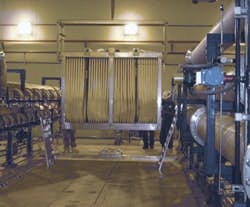Much of Gwinnett County's potable water comes from nearby Lake Lanier, a major reservoir that it shares with four million other Georgia residents, including the City of Atlanta. Several wastewater treatment plants currently discharge reclaimed water into the reservoir or its tributaries, and a proposal was made to allow Gwinnett County's F. Wayne Hill Water Resources Center (WRC) to also discharge into the reservoir and provide high quality reuse water for irrigation of recreation areas.
Ahead of its time
The planning to triple the WRC's output to 60 mgd (227,000 m3/day) began even before the original facility was completed. Phase II would include an expansion of the conventional wastewater treatment equipment and also the addition of a 50 mgd (189,000 m3/day) immersed UF membrane system to provide tertiary ultrafiltration of the secondary effluent. The finished plant will be one of the world's largest tertiary UF plants providing reclaimed water for reuse applications.
Gwinnett County conducted an extensive one-year evaluation and pilot testing process to determine the best available membrane system for the expansion. At the conclusion, ZENON ZeeWeed reinforced hollow fiber membranes were selected from among eight membrane systems supplied by five manufacturers based on performance, cost effectiveness and future flexibility. The design and construction of the upgrade is being handled by the team of Jordan Jones & Goulding, CH2M Hill and Precision Planning and is scheduled for completion by the spring of 2006.
Thousands of membrane fibers hang loosely in each membrane cassette, and a slight vacuum will be applied to the end of each membrane fiber to draw water through microscopic pores and into the hollow fibers. With a nominal pore size of 0.04 mm the membranes form a physical barrier to virtually all suspended solids and provide greater than 4-log removal of pathogens such as Giardia and Cryptosporidium. A permeate header will collect treated water from each membrane fiber, and the water will be pumped to the next step in the treatment process.
The operation of the system will be highly automated, and fibers can be easily cleaned with a clean-in-place backpulsing process that will force permeate water back through the membranes. This will dislodge any particles that may adhere to the membranes. Filtered particles will remain in the process tank, and the rejected water will flow by gravity to the backwash return basin.
Intermittent aeration of the membranes will also be used to scour debris from the fibers. When necessary, in-situ chemical cleaning can be automatically performed if membrane fouling reduces permeability below a specified performance level. Monitoring equipment will ensure that each train meets turbidity and particle count levels and will also indirectly verify the integrity of the membranes.
The high quality ZeeWeed effluent will be blended with high quality effluent from the plant's original granular-media treatment trains before passing through ozonation and granular activated carbon for organics removal. Although the water will only be used for non-potable applications, the quality will exceed many drinking water standards.
With so many highly visible, public applications for the recycled water, the County wants to ensure that all residents understand water reuse is both safe and beneficial. Public education programs are in full swing, explaining that the county has selected the best available wastewater treatment systems to produce water suitable for swimming and fishing that can be safely discharged or reused. Over time, residents will understand how the wastewater treatment plant emulates the systems of nature in purifying wastewater‹and how advanced treatment technologies enable the plant to do it much faster.


